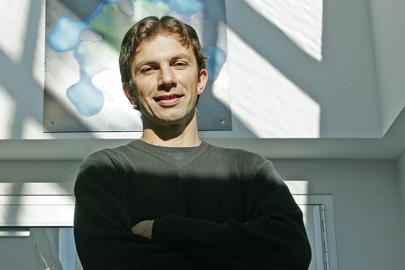Jané Kondev: Unifying biology and physics
At Brandeis, Kondev feels like 'a kid in a candy shop.' He gets to pick and choose from among the most interesting topics in science to break down the walls between disciplines and push the boundaries of knowledge.

When Jané Kondev arrived at Brandeis in 1999, he was a hardcore physicist. He majored in physics in college. He got his PhD in the subject at Cornell. He expected to spend his career in the company of other physicists who like him specialized in statistical physics.
Brandeis is a small place. Scientists run into each other in the hallways all the time. Chemistry professors strike up conversations with computer scientists. Engineers socialize with environmental scientists.
In Kondev’s case, he kept finding himself engaged in fascinating conversations with biologists and biochemists. “They would just show up at my office door and tell me about their research,” Kondev says. “They were asking these really interesting and fascinating questions. I started thinking there’s some really cool stuff going on here.”
Ever since, Kondev has been working at the intersection of the two disciplines, using the quantitative techniques he honed as a physicist to construct mathematical models for understanding life on this planet. He is one of the authors of "Physical Biology of the Cell," a major textbook in the field of biophysics.
In 2014, he was named a Howard Hughes Medical Institute professor, one of the most prestigious honors in the life sciences. With a $1 million grant from HHMI, he established the Quantitative Biology Research Community (QBReC) at Brandeis for undergraduates interested in studying science along with mathematics.
Kondev says the interdisciplinary approach to the sciences at Brandies is unique.
“I think of it as this one-of-a-kind ecosystem where funky new hybrid science disciplines can emerge,” he says. “We have this great innovation culture.” “You feel like a kid in a candy shop,” he adds. “You can try out new ideas here. The barriers are small.”
For the last decade, Kondev has worked with Professor of Biology James Haber on devising three-dimensional models of DNA molecules inside cells. If you unspooled all the DNA in the cell, it would stretch about five feet. But inside the cell, the chromosome gets squeezed into a space of a few microns, or about one thousandth of an inch.
Kondev and Haber’s models capture the shape of DNA in this folded-up state. It then becomes possible to devise mathematical formulas that will predict what will happen when DNA gets damaged and needs repair.
Kondev’s work, and physical biology in general, seek an understanding of cellular processes at their most fundamental and basic level. But over time, the research has the potential to transform modern medicine.
Compare the way engineers design airplanes with the way doctors practice. There’s no guess work in creating the plane. The physics of air flight and wind resistance are well known. Apply the correct mathematical formulas and you can construct a vehicle pretty much guaranteed to work.
In contrast, doctors still have to rely on a good deal of guesswork in diagnosing and treating patients. Advances in biology have reduced reliance on intuition and experience, but not entirely. According to Kondev, this is where physics and mathematics have a crucial role to play.
They can make medicine more akin to engineering. In much the same way physicists understand the forces produced by fluid motion and gravity, doctors would grasp the behavior of DNA or gene expression — through formulas with variables you plug in and use to arrive at precise conclusions.
“You could go to the doctor and they'll run some tests on you and say, ‘This biochemical pathway is screwed up. Let me synthesize this pill that’s made just for you. You’ll feel better tomorrow,’” says Kondev. “In order to do that we need to understand how these things work at the level of basic science.”
This future may be a long way off. In the meantime, Kondev will continue to do what he says he likes best. “My motivation has always been I like solving puzzles,” Kondev says. “I thought when I was younger math and physics had the only puzzles worth solving. In turns out biology has some very cool puzzles too.”
Categories: Research, Science and Technology





